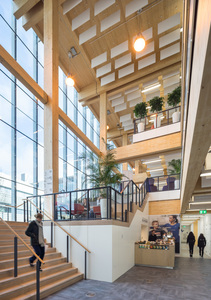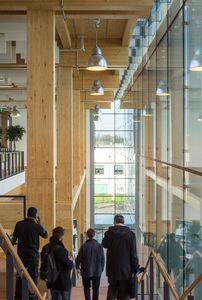

|
Brian Sims
Editor |
Arup issues fire safety guidance document focused on timber-based buildings
04 June 2024
NEW GLOBAL guidance on how to construct fire-safe mass timber structures has been published and released by sustainable development consultancy Arup in a bid to encourage “more widespread deployment” of the low-carbon alternative to concrete and steel.

*Photographs courtesy of Arup © Simon Kennedy
The document sets out an evidence-based approach to support and plug gaps in local country codes and regulations with a view towards assisting in the fire-safe design of mass timber buildings.
While the US, Canada, Australia and several European nations have mature timber construction industries supported by a regulatory framework and special design codes, many other countries are earlier on in their journey.
The authors of the new report firmly believe that the lack of clear and consistent guidance on the global stage is holding back the uptake of this important low-carbon construction material.
The risk-based guide will help fire safety engineers, structural engineers, architects, developers, local authorities, insurance companies, property owners and project managers alike in exploring the use of mass timber to answer essential questions, among them:
*Which fire safety measures are required to address the specific fire hazards posed by mass timber?
*Can all mass timber remain exposed or where does it require encapsulation?
*What fire performance and specification is appropriate for the mass timber components?
*Is a single-staircase building compatible with safe mass timber construction?
*Should mass timber be employed in the construction of external walls?
Reduced carbon emissions
Arup is sharing its internal guidance as part of efforts aimed squarely at reducing carbon emissions to help reach the United Nations goal of making near-zero emission buildings the ‘new normal’ by 2030.
Research conducted by Arup and the World Business Council for Sustainable Development has shown that, of the embodied carbon associated with construction, 70% emanates from six materials including concrete and steel. Using more sustainable materials such as timber in the right way has the potential to dramatically reduce this figure.
The Fire Safe Design of Mass Timber: Global Guidance draws on decades of Arup’s involvement in R&D on fire safety engineering for mass timber structures. This expertise has been used to inform the development of many landmark projects such as the Sky Believe in Better Building here in the UK (pictured) and the Galkangu Bendigo GovHub structure in Australia.
Most recently, Arup has conducted some of the largest timber fire safety experiments in the world. The Code Red research project in France witnessed a series of full-scale fire experiments in a 350 m2 compartment with mass timber ceilings to help the industry better understand how fires would grow, develop and decay in an open-plan space such as an office environment. Arup is also contributing to the development of codes and standards around the world.
The new guide focuses on building typologies where mass timber has the greatest potential: offices and residential buildings up to a height of 50 metres tall and educational buildings up to 25 metres tall.
Often, the sustainability benefits of mass timber structures diminish as the building height increases. However, the guidance (and its underlying research) has also helped to inform mass timber buildings constructed to heights of over 50 metres (such as Haut, the Netherlands’ tallest timber-hybrid residential structure and Ascent, the tallest mass timber construction in the world, which is resident in the US).
Lack of knowledge
Judith Schulz, fire safety engineering lead at Arup (and a special guest on Episode 33 of the Fire Safety Matters Podcast) stated: “As well as gaps in codes and regulations, there’s also a lack of knowledge among much of the design and construction community when it comes to designing fire-safe timber buildings. This means the opportunities for more sustainable construction are not currently being realised. We hope this guide will contribute towards accelerating a move away from carbon-intensive materials and realise a growth in fire-safe mass timber buildings, which offer great promise for reducing CO2 in low-to-medium-rise buildings.”
Arup affirms that the key benefits of timber buildings include the following:
*Sustainable and zero-carbon: the appropriate use of timber can significantly reduce the carbon footprint of many types of buildings and contribute to limiting the carbon emission contributions of the wider construction industry
*Faster and quieter: the use of timber is well-suited to construction in dense urban environments (the fact that it’s lightweight enables less road deliveries and it’s both quiet and quick to assemble, in turn serving to reduce construction noise, time and disruption)
*Reduced waste: timber produces less waste because it can be prefabricated off-site (new digital fabrication technologies enable timber buildings to be constructed very efficiently and, where timber can be left exposed, this avoids the time and cost involved in applying finishes)
*Well-being: there’s a positive impact of timber on human well-being in that integrating wood into buildings can create a warm and natural environment, thereby enhancing occupants’ comfort and well-being)
- National Fire Chiefs Council supports UK’s first Anti-Social Behaviour Awareness Week
- New deputy chief fire officer for South Yorkshire
- Cardiff care home operators fined £400,000-plus due to fire breaches putting residents at “serious risk”
- Council chief quits in wake of Grenfell Tower fire
- NFCC responds to Grenfell report
- National Cyber Security Centre announces latest Cyber Accelerator cohort
- Electrical Safety First launches fire safety-focused manifesto for Scotland’s homes
- Entry process now open for UK Outstanding Security Performance Awards 2021
- Landlord’s license revoked for fire safety failings
- Government of Jersey consults on fire safety laws for tall residential buildings













